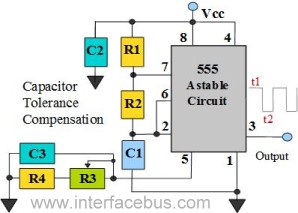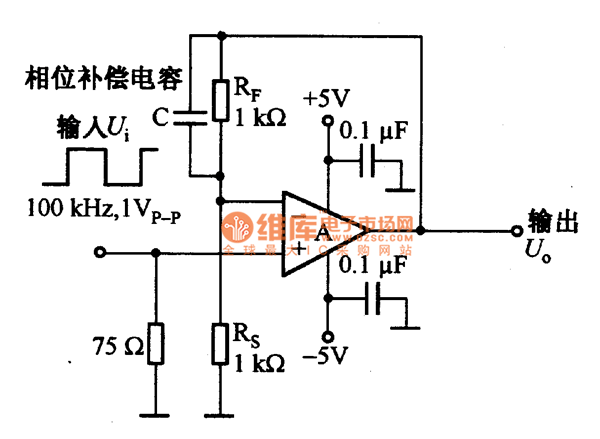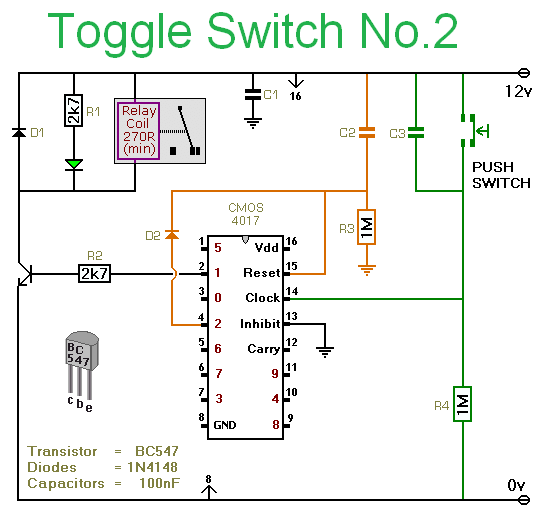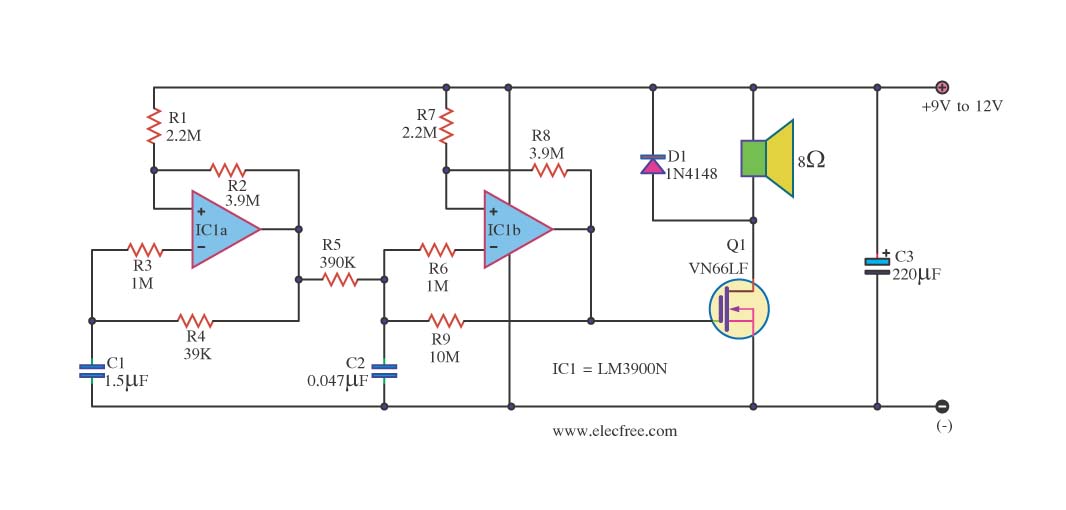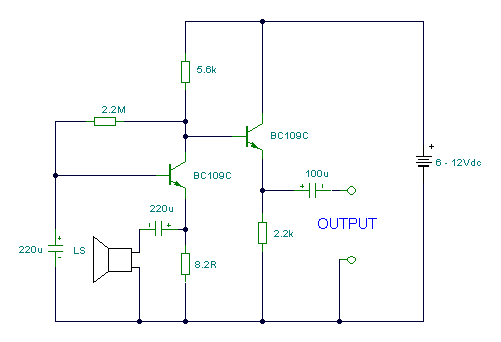
Touch Switch Circuit with explnation
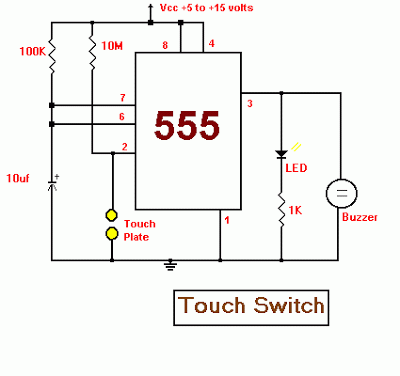
This electronic circuit utilizes a 555 timer as the foundation for a touch switch. When the plate is touched, the 555 timer is activated, causing the output on pin 3 to go high, which turns on the LED and the buzzer for a specified duration. The duration for which the LED and buzzer remain on is determined by the values of the capacitor and resistor connected to pins 6 and 7. The 10M resistor on pin 2 enhances the circuit's sensitivity to touch.
The described electronic circuit is a touch-activated switch based on the 555 timer IC, a versatile component widely used in timer, delay, pulse generation, and oscillator applications. The 555 timer operates in monostable mode in this configuration, where it generates a single output pulse when triggered.
In this circuit, the touch plate acts as a trigger mechanism. When the plate is touched, it sends a signal to pin 2 of the 555 timer, which is configured to respond to a negative-going edge. The 10M resistor connected to pin 2 ensures high sensitivity, allowing the circuit to detect even slight touches. This high-resistance value minimizes the current draw and enhances the responsiveness of the switch.
The timing component of the circuit is determined by the resistor and capacitor connected to pins 6 and 7. The time period for which the output remains high (i.e., the duration that the LED and buzzer are activated) can be calculated using the formula:
\[ T = 1.1 \times R \times C \]
where \( T \) is the time in seconds, \( R \) is the resistance in ohms, and \( C \) is the capacitance in farads. By selecting appropriate values for the resistor and capacitor, the user can customize the duration of the output pulse to suit specific requirements.
The output on pin 3 of the 555 timer is capable of driving an LED directly, providing visual feedback when activated. Additionally, the output can be connected to a buzzer, which produces an audible signal, enhancing the functionality of the touch switch.
Overall, this circuit exemplifies the practical application of the 555 timer in creating a simple yet effective touch-sensitive switch, suitable for various electronic projects and educational purposes.This electronic circuit uses a 555 timer as the bases of the touch switch. You can learn more about 555 timers in the Learning section on my site. When the plate is touched the 555 timer is triggered and the output on pin 3 goes high turning on the LED and the buzzer for a certain period of time. The time that the LED and the buzzer is on is based on the values of the capacitor and resistor connected to pin 6 & 7. The 10M resistor on pin 2 causes the the circuit to be very sensitive to the touch. Disclaimer All files are found using legitimate search engine techniques. This site does not and will not condone hacking into sites to create the links it list. We will and do assume that all links found on the search engines we use are obtained in a legal manner and the webmasters are aware of the links listed on the search engines. If you find a URL that belongs to you, and you did not realize that it was "open to the public", please use the report button to notify the blogmaster of your request to remove it or it will remove within 24 hours.
This is not an invitation for webblog haters to spam with requests to remove content they feel that is objectionable and or unacceptable. Proof of URL ownership is required. NOTICE: This Blog Has Already Been Reviewed And Accepted By Blogger. com 🔗 External reference
The described electronic circuit is a touch-activated switch based on the 555 timer IC, a versatile component widely used in timer, delay, pulse generation, and oscillator applications. The 555 timer operates in monostable mode in this configuration, where it generates a single output pulse when triggered.
In this circuit, the touch plate acts as a trigger mechanism. When the plate is touched, it sends a signal to pin 2 of the 555 timer, which is configured to respond to a negative-going edge. The 10M resistor connected to pin 2 ensures high sensitivity, allowing the circuit to detect even slight touches. This high-resistance value minimizes the current draw and enhances the responsiveness of the switch.
The timing component of the circuit is determined by the resistor and capacitor connected to pins 6 and 7. The time period for which the output remains high (i.e., the duration that the LED and buzzer are activated) can be calculated using the formula:
\[ T = 1.1 \times R \times C \]
where \( T \) is the time in seconds, \( R \) is the resistance in ohms, and \( C \) is the capacitance in farads. By selecting appropriate values for the resistor and capacitor, the user can customize the duration of the output pulse to suit specific requirements.
The output on pin 3 of the 555 timer is capable of driving an LED directly, providing visual feedback when activated. Additionally, the output can be connected to a buzzer, which produces an audible signal, enhancing the functionality of the touch switch.
Overall, this circuit exemplifies the practical application of the 555 timer in creating a simple yet effective touch-sensitive switch, suitable for various electronic projects and educational purposes.This electronic circuit uses a 555 timer as the bases of the touch switch. You can learn more about 555 timers in the Learning section on my site. When the plate is touched the 555 timer is triggered and the output on pin 3 goes high turning on the LED and the buzzer for a certain period of time. The time that the LED and the buzzer is on is based on the values of the capacitor and resistor connected to pin 6 & 7. The 10M resistor on pin 2 causes the the circuit to be very sensitive to the touch. Disclaimer All files are found using legitimate search engine techniques. This site does not and will not condone hacking into sites to create the links it list. We will and do assume that all links found on the search engines we use are obtained in a legal manner and the webmasters are aware of the links listed on the search engines. If you find a URL that belongs to you, and you did not realize that it was "open to the public", please use the report button to notify the blogmaster of your request to remove it or it will remove within 24 hours.
This is not an invitation for webblog haters to spam with requests to remove content they feel that is objectionable and or unacceptable. Proof of URL ownership is required. NOTICE: This Blog Has Already Been Reviewed And Accepted By Blogger. com 🔗 External reference
